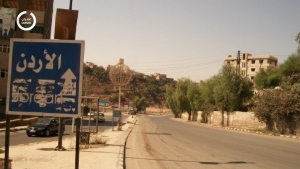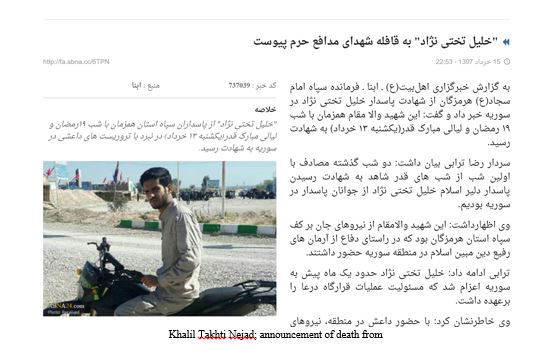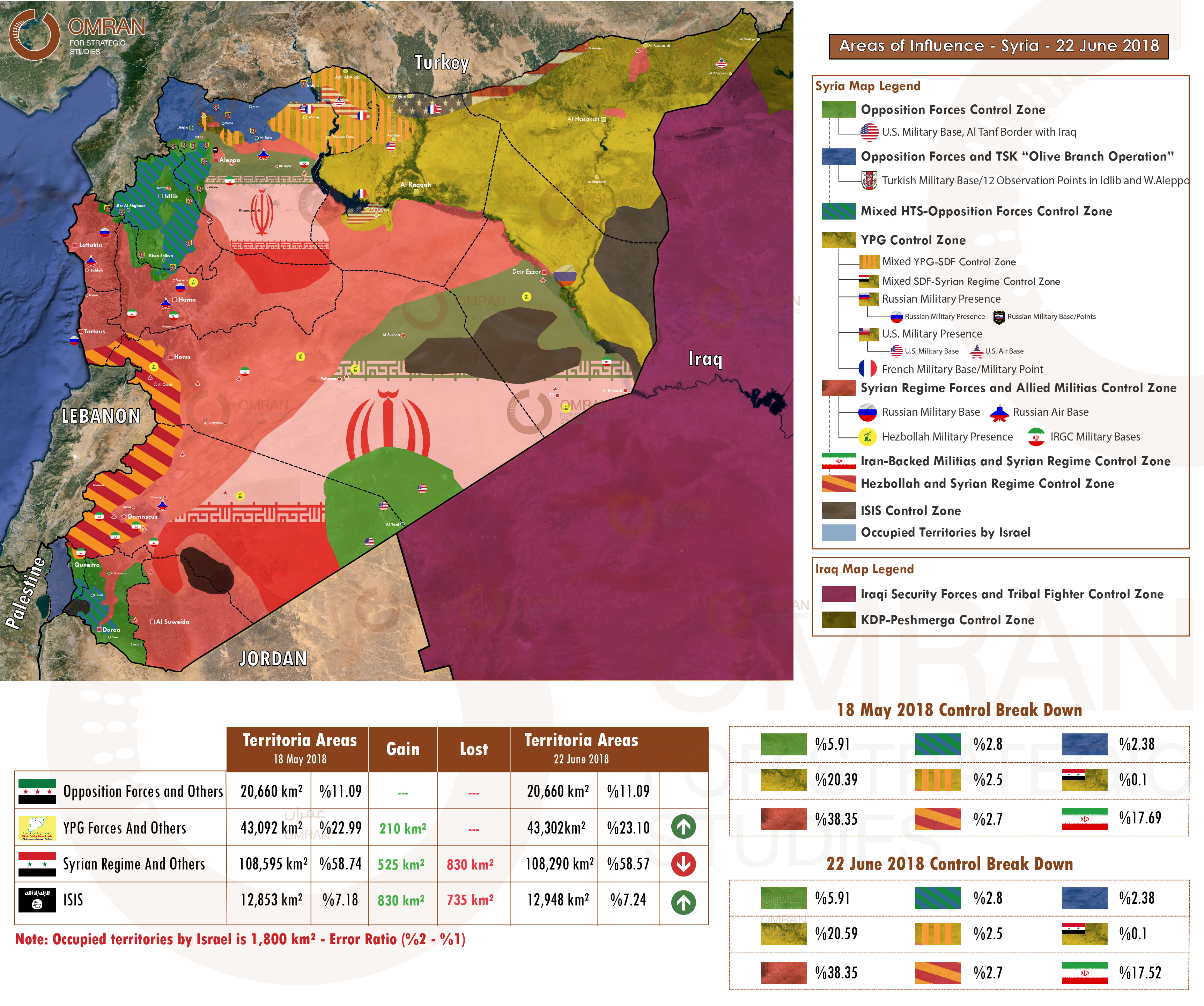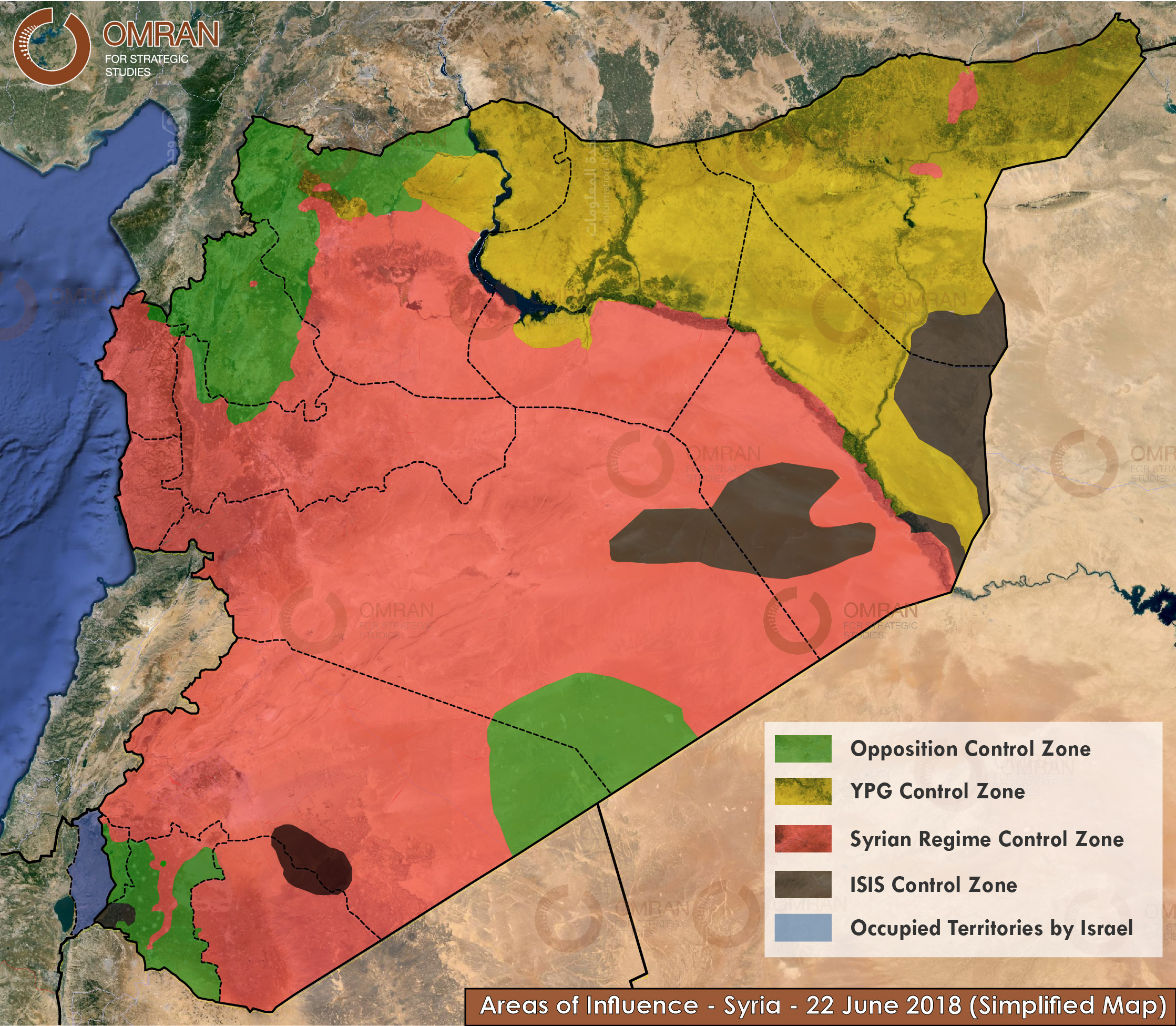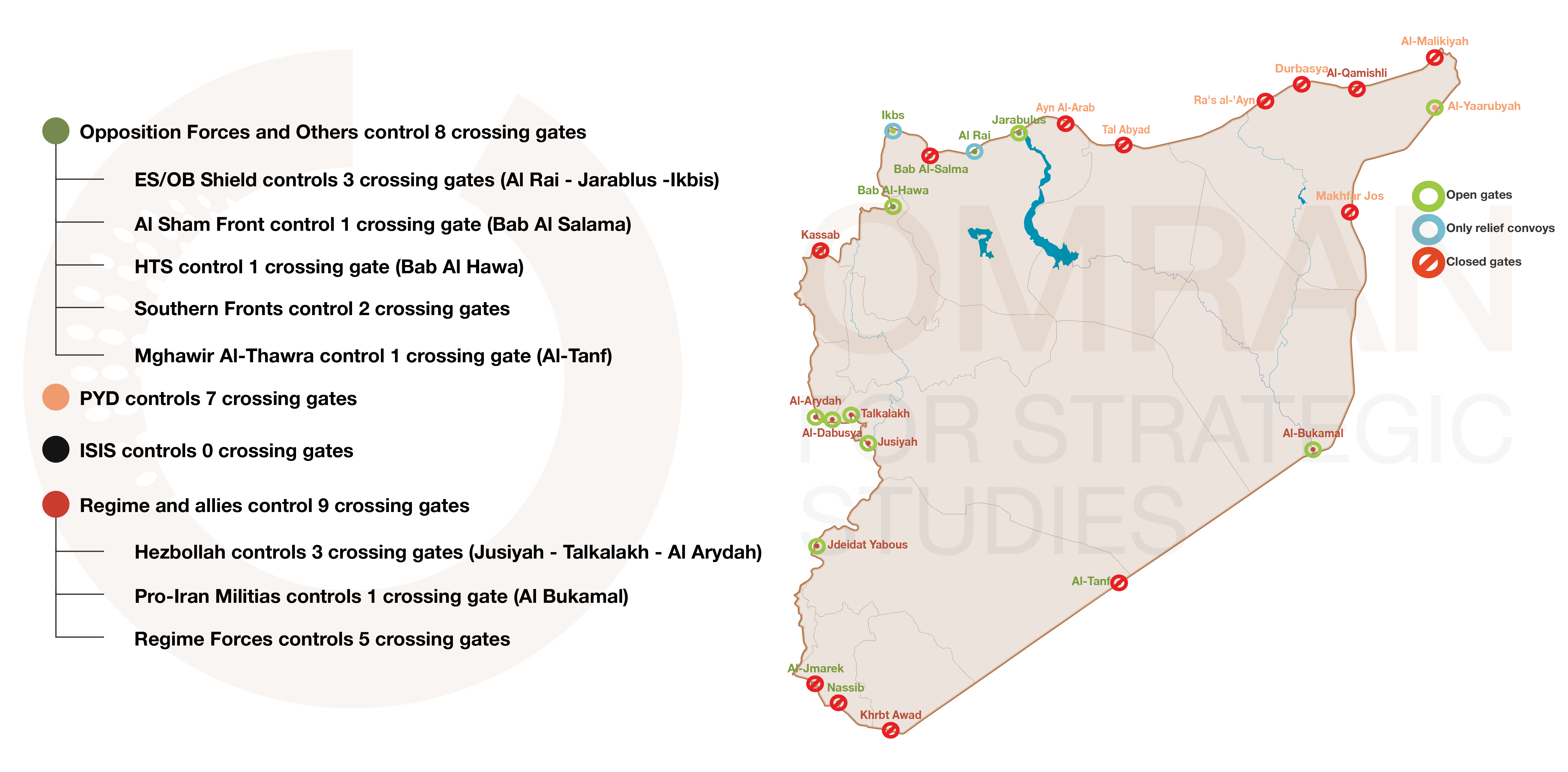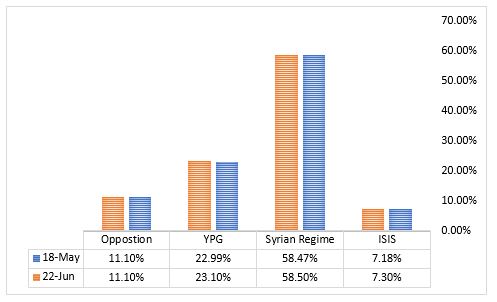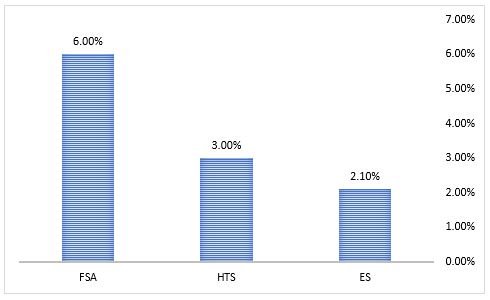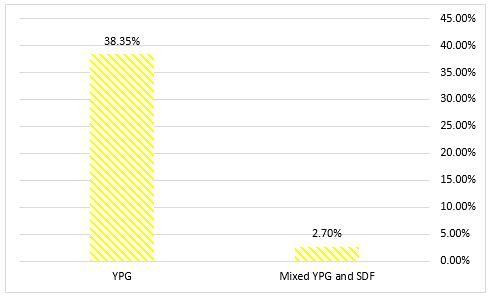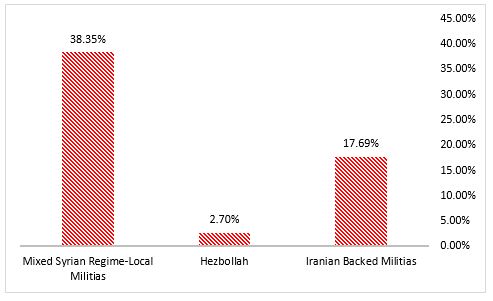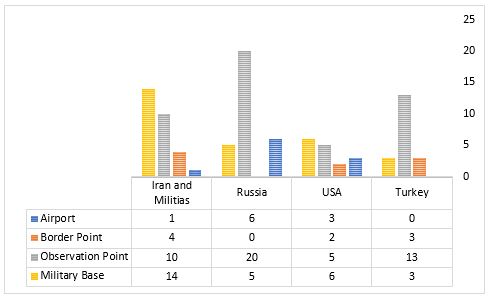From Settlement to Captagon: The Security Dynamics in Syria’s Daraa
The Captagon problem has been one of the most critical security dilemmas for Jordan, due to the increasing attempts of drug and weapon trafficking into its borders that became a threat to Jordan’s national security according to a formal assessment paper, along with the ineffectiveness of the current mechanisms to deter the actors involved in Captagon, particularly Iran-backed militias and the Syrian regime. Although the 2017 de-escalation agreement is supposed to grant Iran-backed militias being pushed back 40 km from the Jordanian border, Russia has not completely fulfilled its pledges. The Russian-sponsored settlements of 2018 and 2021 have failed to introduce a security-providing environment through the DDR process of opposition armed groups in Syria’s Daraa.
The security dynamics of the settlements have played a crucial role in creating a Captagon-friendly environment i.e. the absence of a hegemon actor with the involvement of Russia, Iran, and the regime, in addition to former opposition groups which underwent a transformation process in terms of their motivations (political or economic) and objectives of the use of force (zero-sum or variable-sum). Many of the armed groups that had fought fiercely against the Syrian regime gave up on their political aspiration and became involved in Captagon trafficking. This article provides insight into the security landscape, particularly the interconnection between security and Captagon, as a war economy dynamic, in Syria’s Daraa, and ultimately proposes alternative policy scenarios.
The Status Quo of the Settlements
The settlements of 2018 and 2021 between the Syrian regime and opposition factions under Russian auspices resulted, mainly, in the piecemeal return of the regime’s security apparatuses to the governorate, and the integration of many opposition fighters into these apparatuses, without achieving concrete progress vis-a-vis the detainees or forcibly-disappeared persons in regime’s prisons. Since the first settlement, Daraa has been characterized by a fragile security with the prevailing wide scale, politically motivated to a large extent, violence against various civil and armed individuals, let them be affiliated with the opposition or the regime.
Assassinations and detentions, at which dozens of individuals are targeted monthly, have been the regime’s tools to eliminate his opponents relying, for the most part, on the Military Intelligence Branch of Daraa/Swayda, led by “Loay al-Ali”– an EU, UK, and Canada sanctioned Brigadier-General who was promoted to his current position before the 2018 settlement after he served head of the military intelligence/Daraa section between 2011 and 2018.
Thus, the regime rested on a variable-sum use of force to strengthen its territorial control, eliminate opponents, benefit economically from Captagon trafficking, and underpin its central role in the settlement status quo. Yet, even the transformation of regime behavior from zero-sum to variable-sum is mainly a result of Russian diplomatic coercion and the externally imposed status quo in Syria i.e. the relatively frozen conflict that started to arise in 2018.
The Transformation of the Opposition Armed Groups
Former opposition armed groups in Daraa have pursued different survival strategies to cope with or counter-balance the increasing security leverage of the regime in the governorate. Their transformations have generated different types of armed groups with varying motivations and objectives. While the 8th brigade became mainly motivated by preserving the settlement’s status quo that granted the brigade territorial control over some localities and a maneuvering ability to expand influence; other groups, many of which became associated with the regime, have relinquished their political motivations for economic ones through getting involved in Captagon trafficking and/or thuggery activities.
The 8th brigade led by the former opposition commander, Ahmed al-Oda, and composed mainly of former opposition fighters of “Sunna Youth Forces,” has maintained its territorial control in Eastern Daraa’s Busra al-Sham since its establishment under Russian auspices in the aftermath of the first settlement in 2018. Given the relatively secure environment with the lowest assassination rate and the better governance services in areas under its control in comparison with other areas in Daraa, the brigade has managed to preserve social support and counterbalance the regime’s influence seeking to preserve the settlement status quo. Yet, the brigade increased its leverage through variable-sum use of force.
The 8th brigade conducted multiple security operations against ISIS or groups accused of ISIS affiliation in different parts of Daraa such as Jasim in Western Daraa in August 2022 and Daraa al-Balad neighborhood where the operation eliminated the Hafo-Harfoush militia in December 2022. These operations were conducted after the regime’s escalation and threats to launch offensives in these areas under the pretext of ISIS cells, in which the 8th brigade capitalized on the social rejection of the regime’s interference and its connections with local Sheikhs and dignitaries. In addition to its previous intermediary role between the regime and local communities to ease escalation such as the cases of the 2022 March escalation in Jasim and the 2020 February escalation in al-Sanamayn city Northwestern Daraa. Moreover, the 8th brigade has also targeted other groups involved in Captagon trafficking in Northeastern Daraa including a group affiliated with Fayez al-Radi, a former opposition commander assassinated after an escalation with the 8th brigade.
Other groups such as those led by Mustafa al-Masalmeh and Imad Abu Zureiq, the two former opposition commanders, have not only given up their political struggle against the regime after the settlement but also became affiliated with the regime, as they became motivated by economic motives under the new status quo, where the regime became superior. As such, they have been involved in trafficking Captagon drugs, imposing levies on locals, and conducting assassinations against regime opponents on behalf of the military intelligence – which is managing militias and receiving levies from them.
By April 2023, both Abu Zureiq and al-Masalmeh were sanctioned, along with Assad family-affiliated individuals including his cousins, by the U.S., EU, and UK for their involvement in the production and export of the Captagon. However, al-Masalmeh was later killed after several attempts on his life by local factions due to his involvement in assassinating numerous opponents of the regime.
Hafo-Harfoush militia is another armed group led by two former opposition commanders Muhammad al-Masalmeh and Moayad Abdel-Rahman who -unlike other opposition groups- rejected the settlements and refused to be displaced to Northern Syria. They were, territorially, located in Daraa al-Balad neighborhoods until getting defeated by local factions supported by the 8th brigade in November 2022, for their links to ISIS cells, implication in assassinations against opposition figures based on revenge motives, and involvement in thuggery activities such as theft and imposing levies on locals. All of these security dynamics illustrate the overlap of security and war economy, notably the Captagon trade.
Alternative Policies: Addressing the Captagon Dilemma
Sanctions have not been effective in impelling the regime to make concrete concessions or changes such as in the case of the military intelligence in Daraa and similarly had no impact on the former opposition commanders, currently affiliated with the regime. The Arab engagement with the Syrian regime has not only failed to make progress in countering the Captagon trafficking, but the trafficking itself also increased after the normalization talks that led to the regime’s return to the Arab League in May, let alone the increasing technological capabilities of drug traffickers such as the use of drones.
For regional policy implication: First, Jordanian national security should be considered vital for regional security by Jordan’s international and Arab allies against the Iranian aspiration for a next domino after Lebanon, Iraq, Yemen, and Syria. Second, the assumption that the Syrian regime possesses the willingness and/or the capacity to counter the Captagon problem or disassociate from Iran should be reconsidered. Third, policy options should account for the interconnection of regime-affiliated security actors and Captagon trafficking, and the increasing capabilities of Captagon networks. The May statement by the Jordanian foreign minister on the prospect of taking military action to counter the Captagon threat in Syria and the three Jordanian airstrikes targeting drug smugglers and factories in May, August, and December, highlight an alternative policy based on coercive means that can and should be adopted in countering drug trafficking.
Given the lack of a comprehensive solution, three alternative policy scenarios can be illustrated:
- Strengthening state institutions: The interconnection between the regime and the smuggling networks, its use of the Captagon as a weapon, and the current inability to enforce security sector reform on the regime render the latter unreliable in countering the Captagon.
- Proactive targeting of Captagon networks: The Jordanian previous airstrikes were reactive in nature and limited in scale. A proactive strategy shall, rather, be focused on targeting the factories operating in different locations across Syria as well as the Captagon barons. Such a strategy requires U.S. and regional support in addition to coordination with Russia.
- Buffer zone: A demilitarization process in Southern Syria that necessarily requires a new status quo i.e. a new agreement with Russia and a new settlement that involves demilitarization. Such a scenario would prevent a potential spillover of the Gaza war to Southern Syria – which is, perhaps, in the interest of all parties involved. However, the technical challenges in enforcing and monitoring such settlement will not be easy to deal with.
Finally, the dynamics of the settlement in Daraa, its security repercussions, and its interconnection with the war economy can no longer be ignored, especially with the outstanding risk of spillover into the neighboring Sweida that has been gripped by a state of unrest since August.
The Source : Politics and Society Institute
Article link: https://bit.ly/3GZZjSc
The situation in Daraa is dire. Here’s how it might play out.
In a symbolic blow to the anti-government uprising born in Daraa in 2011, the Bashar al-Assad regime and Iran-backed militias are once again attempting to violently subdue the Syrian provincial capital, which is considered the birthplace of the revolution that began a decade ago.
The most recent round of clashes was sparked by Syria’s May 31 illegitimate presidential elections. Several of Daraa province’s cities refused to participate in the elections and civilians took to the streets in protest.
On the day of the elections, the Syrian regime was forced to move the election center from the Baath Party Division building in Nawa city to the district center in the middle of the security square, where branches of the regime security agencies are located. This prompted the flight of most of the working members of the party’s division to the capital, Damascus, for fear of being targeted.
As a result, several neighborhoods in Daraa province were placed under a brutal siege. In late June, the Fourth Division of the Syrian army and other regime forces encircled the city and cut off all roads leading to Daraa al-Balad in the south, preventing the entry of food and medicine as well as the entry or exit of civilians. The regime and its allies proceeded to cut off electricity, water, and communications. One checkpoint remains open for residents, but it is under the control of the Military Security Branch and the Mustafa al-Kassem militia—a troubling scenario for civilians.
Daraa hasn’t witnessed a military campaign like this since the regime took control of the province in July 2018. Following that takeover, the region was divided into settlement areas, as happened in Daraa al-Balad, Busra al-Sham, Tafas, and other areas under regime control (MAP 1). Members of the Free Syrian Army (FSA) remained, forming sleeper cells, such as the Popular Resistance in the south—an armed group from Daraa province that was formed in November 2018—in several towns that refused the terms of a settlement with the regime, which exposed them to attacks. Other formations of the FSA joined the Fifth Corps—a volunteer-based force—under direct Russian control. The most prominent outgrowth was the Sunni Youth Forces, which now forms the forces of the Eighth Brigade in the Fifth Corps.
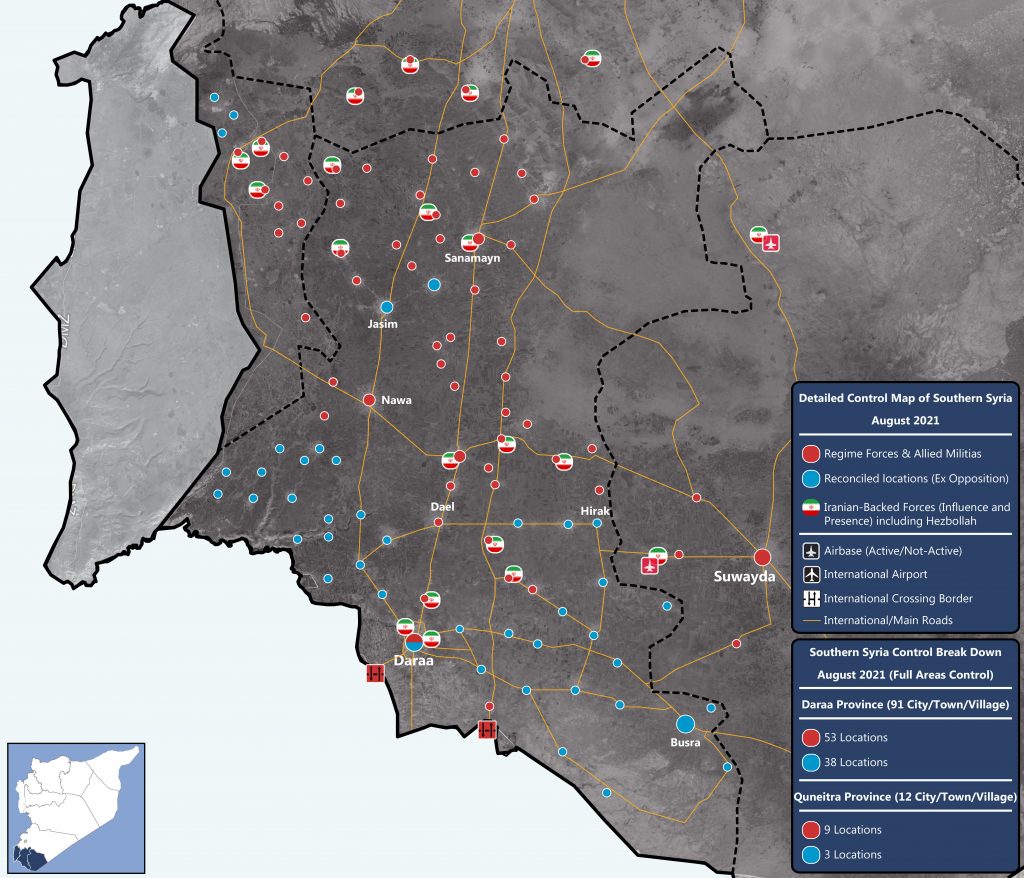
The complex reality of influence and control after the 2018 settlement
Despite the Assad regime’s control over Daraa since the 2018 settlement, the reality on the ground indicates that there are three spheres of influence in the province. The first is the area considered the center of negotiations between the opposition and regime, which is under direct Russian supervision. In this area, the regime maintained institutional control but was denied a security presence. The second sphere of influence comprises of settlements where the regime has all-out military control, such as Bosra al-Harir, al-Harak, Saida, and surrounding towns, as well as western areas like Jassem and Newa. Lastly, the third includes areas seized by the regime without signing a settlement agreement, such as Dael, Inkhil, and al-Hara.
Iran’s consolidation of influence in Daraa is one significant implication of this power diffusion. Via the Fourth Division, the Islamic Revolutionary Guard Corps, and militias deployed in Daraa, Iran has successfully expanded its influence in the south and established a military presence in strategic locations near Syria’s southern border. Recent developments are further evidence of Russia’s failure to contain Iran in Daraa. While the Russians led the initial negotiations, Iran subsequently upended the process, empowering local allies to take military control of the province.
Daraa developments in light of the regime’s army being dispersed between Russia and Iran
Beginning on June 25, regime forces imposed a complete siege on the neighborhoods of Daraa al-Balad (inhabited by approximately fifty thousand people): the internally displaced camp, Palestinian refugee camp, al-Sad Road, and the farms in the areas of Shiah, al-Nakhla, al-Rahiya, and al-Khawani. The siege is meant to punish civilians for ongoing demonstrations since 2018 and the refusal of Dara al-Balad residents to participate in the voting process. As the dispute escalated, the Central Committee of Daraa al-Balad met with Russian General Assad Allah, who threatened to storm dissenting neighborhoods but agreed to prevent Iran-backed forces from taking military action in the city.
After several meetings between the Central Committee and regime, the two parties agreed to hand over the remaining light weapons of former FSA fighters who are not part of the Fifth Corps in exchange for lifting the siege imposed on Daraa al-Balad and an end to the regime’s military campaign there. The two sides also agreed to construct a new settlement to clarify missing or gray areas in the 2018 settlement.
However, the agreement has not been implemented so far due to several obstacles created by Major General Husam Louka, the head of General Security Directorate, Brigadier General Ghaith Dalah, commander of the Fourth Division, and Syrian Defense Minister Ali Ayoub—all of whom have stated that the regime’s goal is absolute control over the entire neighborhood of Daraa al-Balad. This proclamation upset the Russians, who know Iran is escalating the conflict and attempting to strengthen the control of its local allies near the Syrian and Jordanian borders.
It is possible to deduce several important points from the rapid developments in Daraa al-Balad during the past week:
- The non-interference of the Russians during the military operation via airstrikes gave ex-FSA fighters ease of movement. The Russians’ lack of intervention may also explain their unwillingness to complicate the situation of the opposition-held areas in the north, and not to assist the Iranian allies on the ground to advance in a way that would hurt the fragile agreement between Russia and Turkey there.
- The fall of many regime military points and checkpoints within hours to the hands of ex-FSA using only light weapons indicates the fragility of the regime army’s structure in these locations. This fragility is due to their dependence on untrained fighters and/or a collapse of the soldiers’ morale.
- The rapid response of other settlement locations—blocking roads and attacking regime security points—in the eastern and western countryside of Daraa contributed greatly to the dispersal of the regime’s focus on a specific geographic area.
- The media campaign that started at the beginning of the siege on Daraa al-Balad incited international responses. The United States and the European Union issued several official statements condemning the campaign and calling for an immediate ceasefire.
Amidst this military escalation on Daraa al-Balad and the eastern and western countryside and the continuation of negotiations between the Central Committee and the regime, Daraa faces several scenarios.
A new settlement and forced displacement
The way the Assad regime dealt with the cities of Tafas and al-Sanamayn could foreshadow what happens in Daraa al-Balad in the coming days. After the regime attack on the city of al- Sanamayn in March, Russia intervened through the Fifth Corps to resolve the conflict and imposed a truce that ended with the deportation of fighters to the north; those who stayed have had to hand over weapons. In January, the same scenario occurred in Tafas, after the regime demanded that the people hand over light and medium weapons and that those who wished to leave Daraa go north.
According to this scenario, Russia may intervene to end the attack on Daraa al-Balad, put an end to the military operation, and sign a new agreement. However, the details and terms depend on the size of the Assad regime’s losses in the coming days. This seems to be the most realistic scenario for the regime, considering its accelerated losses and negotiations with the Central Committee of Daraa.
The area under the shadow of the Fifth Corps
The FSA’s recent success will give it an upper hand at the negotiating table. The Central Committee may negotiate a stop to the escalation in all towns and cities in return for stopping the military campaign, lifting the siege, and deploying checkpoints for the Fifth Corps in Daraa. Although this scenario is possible, it requires the approval of Russia and Jordan and it is unlikely that Iran and the regime will accept this scenario, which would threaten their control in the south.
Return to the 2018 settlement
If the Russians do not intervene in the coming days to stop the regime’s military campaign and the FSA continues to maintain the military escalation line and preserve its gains on the ground, the regime may turn to pre-June 25 conditions to prevent further losses and the further bolstering of the opposition. The situation at the time gave the regime full administrative control over the area but with very limited security control.
Worst case scenario: absolute control by the regime without any reconciliations or settlement
This scenario is best for the Assad regime and its ally Iran, which does not favor Russia. It depends on launching a vast military campaign on the neighborhood and imposing absolute control without referring to any new settlements, which will result in a massive campaign of arrests for the residents and will not even allow them to flee to the north of Syria. This scenario is preferable for Iran because it will create a large vacuum in the region that can be exploited by local allies at the administrative, military, and security level, which will therefore pose a major challenge to Russia in regard to controlling the Iranian presence near the Syrian and Jordanian borders.
In the long run, this scenario will enhance the fragility of the security situation in the region for an array of reasons. This includes: an increase in assassinations against Iran’s allies in the region; the high incidence of clashes between members of the Eighth Brigade and Iran’s allies; and an increase in the number of Israeli attacks on Iran-backed forces. In sum, this scenario is considered the worst for Daraa and its people because it serves only Iran and its local allies from the regime.
Nawar Oliver | Russian Truce in Idlib and Hama and the initial reaction
Nawar Oliver, Omran Center military expert and the Information Unit manager on 2nd of Aug 2019, gave his remarks to the AFP about Russian Truce in Idlib and Hama and the initial reaction of some Opposition factions.
Oliver added, “Russia will continue to bomb civilians locations and carry out massacres, and keep on supporting the Regime ground attack during this ceasefire , The Russian has a long bad history when it comes to ceasefires with the oppositions faction, such as in Eastern Ghouta, Northern Homs, and Daraa.
Source: https://yhoo.it/2Yrc3NW
Dr. Ammar Kahf, Commented on latest developments in southern Syria
On the 25th of July, Dr. Ammar Kahf, the executive director of the Omran, commented on latest developments in southern Syria to USA Today, by stating that the regime’s territorial gains in Daraa has put Iran and Hezbollah closer to being a threat to Israel and regional powers.
This development will increase the likelihood of greater conflict in the Middle East. Developments in Daraa are also signs of a new era in the Syrian conflict, where domestic actors have largely disappeared and given way to international and non-state actors using Syria for their own agenda.
Dr. Kahf has stated that “The story of the armed Syrian opposition is over, Iran and Hezbollah are much stronger today than a month ago and closer to the southern front. I think this (Syrian conflict) will continue to escalate.”
Special thanks to the co-writers of the Article, Jacob Wirtschafter and Gilgamesh Nabeel.
Source: https://usat.ly/2NPpBc6
Iranian Involvement in Syria’s Southern Front
This report presents a brief account of latest developments in southern Syria, covering the Daraa and Qunaitera fronts with a specific focus on Iranian involvement from late May until July 17. Prior to the latest escalation along the southern border of Syria, there were reports of an initial agreement between Israel and Russia to push back Iranian and Iranian-backed forces along Syria’s border with Israel. The Iranians reacted by incorporating many of its militias and forces into the Syrian army to continue fighting in the area. Photographs and videos posted on pro-regime media as well as accounts belonging to some of the Iranian-backed militias confirm their involvement. In the final agreement between opposition forces and Russia involving parts of Eastern Daraa and Daraa city, green buses headed to the area to prepare the transportation of a small number of the opposition members to Idlib, while other areas concluded reconciliation agreements. Other areas to the west of Daraa are still going through negotiations to finalize the terms of their agreements. The Russians are pushing for an agreement where minimum number of residents are displaced to Idlib, as a deal to receive them was not concluded with Turkey. At the same time, Iranian forces are pushing for the escalation of attacks to take full control of all southern regions.
Background
In late May 2018, Israel and Russia agreed that Iranian and Iranian-backed forces would vacate areas in southwestern Syria near the Israeli border([1]). Russian President Vladimir Putin stated that due to the Syrian army’s recent advances, foreign forces should withdraw from Syria and mentioned Turkish, American, Iranian and Hezbollah soldiers specifically when asked to clarify. Iranian Foreign Ministry representative Bahram Qassemi responded that Iran would remain in Syria while terrorism exists and for as long as the Syrian government wants Iranian forces there([2]). Nevertheless, in order to reduce pressure from Israel, Iranian-backed forces – including some of Hezbollah members – withdrew from areas in southern Syria only to return as integrated units within the Syrian Army structure. Examples of Iranian-backed forces within the Army include the following:
- 313th Brigade: This brigade is stationed at the Cultural Center in the city of Azra. Brigade fighters withdrew from the city of Daraa in the first week of June and went back to their main base in Sa'Sa.
- Quneitra Hawks: This force is comprised of 200 fighters and was affiliated with Lebanese Hezbollah. It was initially de-mobilized in Khan Arnabeh and then immediately regrouped and joined the 7th Division of the Syrian Army.
- Iranian-backed militias are now stationed in the hills surrounding the towns of Tel Musabah, Tel Arabad, Tel Marz, Tel Ghassem and Tel Ghashim, before they were divided into three units and re-deployed.
- A group of Lebanese Hezbollah fighters were deployed to the town of Khan Arnebeh as part of the 5th Division.
- Al Ghith Forces: This force is affiliated with the 4th Division and was deployed in Khdir Village, on the west side of Majdal Shams.
- Abu al-Fadl al-Abbas Brigade: This brigade withdrew from Eastern Ghouta and moved towards Damascus, only to return after a few days. It is now stationed at Khan Aranbeh and Al-Baath City in Quneitra, at the base of the 10th Brigade in Qantara. Information Unit Sources confirmed the existence of a training camp for the fighters of Abu al-Fadl al-Abbas in Qalmoun, which includes Afghan and Pakistani fighters. The objective of the camp is to send them to the southern front until the Syrian government prepares new identity cards for these fighters as Syrian citizens.
In early June, Russia began deploying troops near territories occupied by Israel, indicating Moscow’s preference for decreased Iranian presence in Syria and despite the dominant presence of Hezbollah in the area. Sources confirmed that Hezbollah was not happy with Russian moves and would demand Russian withdrawal, similar to what happened in Al-Qusir, Homs in the first week of June. Conveying Iranian opinion, Brig. Gen. Masoud Jazayeri told Lebanon’s al-Manar, “Iran and Syria enjoy deep relations that would not be influenced by the propaganda measures of anyone,” adding also that Lebanese militias would not leave Syria([3]).
Attack Stage
The following is a list of top Iranian-backed militias and forces involved in the escalation of violence in the southern front:
| Militia Name | Origin | Situation in Syria |
| Imam al Baqir Brigade | Syria | Part of LDF |
| Lebanese Hezbollah | Lebanon | Special Forces |
| Saryaa Al-Arin | Syria | Military Security Branch |
| Zu Al-Fiqar Brigade | Iraq | Republican Guard |
| Imam Hussein Brigade | Iraq | Militia |
| Al Quds Brigade | Palestine | Militia |
| Abu Fadl Al-Abba | Iraq | Republican Guard |
| A Taha Regiment | Syria | Tiger Forces |
| Arab National Guard | Mix | Militia |
| Salah Al-Assi groups | Syria | Tiger Forces |
| IRGC | Iran | Military supervision |
At the end of June, Syrian regime and Iranian-backed forces – with the support of the Russian Air Force – began the attack on Daraa, quickly capturing a number of cities in a matter of days. Following this rapid advance, various towns throughout Daraa accepted reconciliation agreements with the Syrian regime, including the towns of Um Oualad, Saida, Um Mayazin, Taybah, Nassib, Jabib, Ibta, and Da’il. By the first week of July, Syrian regime and Iranian-backed forces along with the Russian military police had surrounded Nasib border crossing after capturing the city itself. According to Information Unit Source, the presence of Russian military police is part of an undeclared agreement between Russia and Jordan to ensure that Iranian-backed militias do not enter through the Nasib Crossing. However, as these militias integrated themselves into different Syrian army groups, it is difficult to monitor their presence in Daraa.
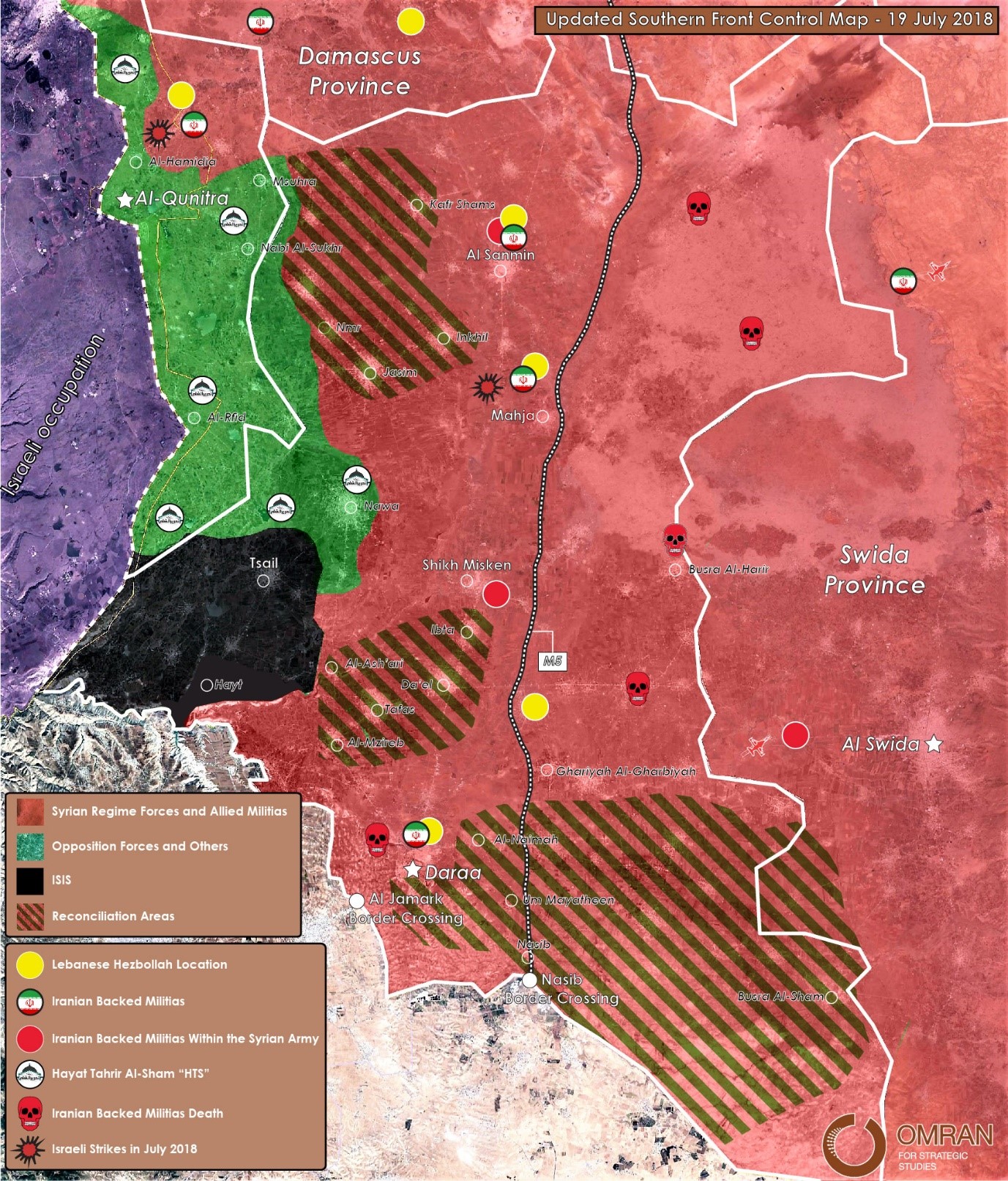
Map (1): Updated Southern Front Control Map - 19 July 2018
Iranian-backed forces suffered a number of casualties during the attack on Daraa, losing more than 50 top-level fighters – among these fighters were those from Hezbollah, as well as Khalil Takhti Nejad, a fighter for the IRGC. Nejad was deployed to Syria as a member of the Imam Sajjad IRGC Hormozgan Provincial Unit and commanded an operation from an unnamed base in a southwestern Syrian city of Daraa, approximately 32 km from Israel’s northern border.
Note: chart only indicates the number of dead among top Iranian-backed militias who participated directly in the recent Daraa battle; information obtained from monitoring pro-regime websites and official militia accounts.[4]
By the second week of July, Syrian regime and Iranian-backed militias announced that they had captured 520 km2 in Daraa province; 290 km2 from military operations and the remaining 230 km2 following a deal between Russia and the opposition factions. Syrian regime and Iranian-backed militias continued to advance along the Syrian-Jordanian border and reached the town of Khrab al-Shahm, facing no resistance from the opposition as most opposition forces had withdrawn from the borderline earlier.
Footage from Daraa battle of Iranian participation
The images below were taken from official media accounts of the participating militias and from pro-regime accounts.
Eastern Daraa Agreement and Western Daraa ongoing Negotiation
The situation in Daraa remains unclear. Four major events that are underway include:
- Green buses are waiting in pro-regime areas in Izra to transport a small amount of the opposition to Idlib as part of Friday’s 6th of July reconciliation agreement.
- Opposition commanders in the east and west are divided about what to do next. A commander([5]) in the east stated that opposition fighters would be responsible for the security situation in east Daraa for six months alongside Russian military police. At the same time, opposition forces in western Daraa rejected the agreement that took place in the east and announced they would hold their ground for now. A number of commanders escaped from Daraa to Jordan, including Bashar al-Zu'bi, Abu Omar Zaghloul, Raed Radi, Emad Abu Zureiq, Morhaf Al-Aboud, Anas Al-Zaeym, Ziad Al-Ghorani, Iyad Kaddour, Ziad Hariri Al-Bardan, and Abu Sidra Mashhour Canacry.
- Jordanian military commander Gen. Khaled al-Massa’id said reopening the Nasib border crossing would benefit both countries, in both security and economic aspects([6]).
- On 15 July, the first batch of civilians and fighters displaced from Daraa city arrived to Qalaat al-Madiq in Northern Hama. This batch consisted of 9 buses and 2 ambulances carrying at least 430 civilians and fighters.
About 20 buses are expected to depart with hundreds of civilians and fighters of Islamic factions with their families. There were about 1400 people expected to depart but the committees which are close to Russia are trying to persuade people to stay instead of evacuating to the north for the following reasons:
- Russians do not want Aleppo and Deir Ezzor experience to repeat itself, and allow Iranian backed forces to fill the gap in any displaced area.
- Russians tried to preserve the solid security situation in Daraa by transforming some of the opposition forces into local security forces responsible of protecting their own cities.
Note: In regards to Quneitra, there is no agreement until now and no initial negotiation between the Russian and any faction of the opposition forces. Russian negotiators want HTS to leave its post before starting any kind of negotiations.
The situation is being continually monitored in order to maintain an eye on what changes occur. The opposition’s divided actions will continue to leave it exposed to manipulation by outside forces. The Syrian regime will further its presence in the south by playing off the Israel-Russia-Iran trio; and Jordan will observe silently without exerting much effort in terms of actual fighting with or against any of the parties involved. With Russian forces gaining more ground in Syria whether at the behest of the Syrian regime or by making unilateral moves, it will be crucial – albeit difficult – to observe how Iran proceeds to protect itself and its assets in Syria.
([1]) 29 May 2018 – Telegraph - https://goo.gl/Z5jFUh
([2]) 8 July 2018 – Fares News - https://goo.gl/3KdLpU
([3]) 10 June 2018 – Daily Sabah - https://goo.gl/noyzPV
([4]) These number from monitoring Pro Regime and Iranian backed militias account, and also by special report from the Information Unit Ground Sources
([5]) 10 July 2018 – Skype Interview by the Information unit with a commander from the Southern Front
([6]) 16 July 2018 – Al Masder News - https://goo.gl/zyKA28
Special Areas of Control and Influence Report June 2018
Updated Influence report and map of Syria 22 June 2018 with % of Gains & Losses in the last 34 Days. Ongoing battles on the Northeast front of Daraa, Regime and allies forces with Russian air support of are trying to control the area to the east of Damascus - Daraa international highway to Nasib crossing gate.
Meanwhile YPG with US support launched a new Military Campaign against ISIS in Southern Hassaka.
Updated Map: Areas of Influence and Control
Map (1): Areas of Influence - Syria - 22 June 2018
Map (2): Areas of Influence - Syria - 22 June 2018 (Simplified Map)
Map (3): Crossing Gate Control Breakdown and Current Situation
Percentage of Control Breakdown
Chart (1): Simplified Percentage of Control (May vs. June) 2018
Note: The charts below show the percentage of total Syrian territory that each faction controls.
Chart (2): Percentage of Syrian Territory Controlled by Opposition Groups
Chart (3): Percentage of Syrian Territory controlled by the YPG
Chart (3): Percentage of Syrian Regime and Allies Control Areas Breakdown
Presence of International Forces
Chart (4): Main International Military Bases and Airports – June 2018
Territorial Control Map - Qunitra - 21 Dec. 2017
Iran has continued its attempts to expand in southern Syria despite international agreements aimed at curbing its role in the area. Russian and American the influential countries in southern Syria consider the arrival of Iranian militias to the Jordanian-Syrian border and the border of the Israeli-occupied Golan Heights to be “a red line,” which has necessitated direct interventions. Despite this, Iran has continued its expansion as part of the encirclement, which it has pursued in recent months.
Quneitra Front and Western Ghouta Battle Timeline (November – December)
- November 3, Regime Forces and Hezbollah repelled a large attack of HTS, in "Hadr" city in the northern side of the Golan Heights.
- 17 November, Israeli tank attacks Hezbollah “Qars Nafal” position between "Hadr" & "Ain Teenah" position, in the western side of Quneitra.
- 23 November, Hezbollah takes control of South "Beit Tima" after taking control of "Halef shor" and "Tell Al Teen."
- 30 November, Hezbollah and Regime forces established full control over the strategic hills of "Taloul Barda’yah" near the occupied Golan Heights.
- 10 December, Hezbollah and Regime forces have secured their recent gains in the Beit Jinn pocket in southern Syria.
- 13 December, According to pro-regime Medias, Regime forces, and allies will continue their operations in the area until they liberate the entire pocket or local militants accept a withdrawal agreement to Idlib.
- 17 December, Members (HTS) have reportedly started withdrawing from the village of "Maghr Al Meer" to the town of "Beit Jinn" in southern Syria.
- 19 December, According to pro-regime sources, Regime Forces, and Allies reached the eastern entrance to the village of "Maghar Al Meer." However, they were not able to enter the village because they failed to capture the nearby height – Tal Marwan (Marwan Hill).
Brigade 313 "IRGC New Military Formation"
In November 2017, Daraa province has witnessed surprising competition between Iran and Regime forces around the conscription of Syrian young men from the province, as well as the formation of a new force, Brigade 313, which is under the authority of the Iranian Revolutionary Guard.
Despite the Iranian-led brigade only being around for a number of months, it has attracted more than 200 young men; members who were conscripted for the formation were young men from Daraa who were known to work on behalf of the regime, who were currently promoting the force based on its benefits, and the salary, which its members received.
Enlistment takes place at the Brigade 313 headquarters in the city of Sa'Sa', and new members receive an ID, which has the logo of the Revolutionary Guard, ensuring his ability to pass through Regime forces checkpoints.
Analysis: The Battlefield in Syria’s Southernmost City, Daraa
In recent weeks Daraa has witnessed the most intense clashes and aerial bombardments it has seen for years. Despite the plan for “de-escalation zones,” civilians in the city are likely to becaught in the newest battlefield for foreign power proxies and the warring Syrian sides.
ISTANBUL– When the Syrian government announced a 48-hour cessation of hostilities in Daraa on Saturday, some residents of the southern city were skeptical.
The brief pause in fighting, which ended on Tuesday as the Syrian army and its allied forces resumed their operation, came after two weeks of some of the most intense aerial bombardments and clashes the city has seen since 2015. Some saw the pause in fighting as a victory for the rebels who control the city and who have been resisting a government advance in the area since February. Others, however, were worried that the temporary halt was a cover for pro-government forces to bring in reinforcements.
The truce was announced just as the dates were set for the next round of United Nations-led peace talks in Geneva (July 10) and Russia-led negotiations in Astana (July 4–5). In theory, it sounded promising. Syrian state-run media said the purpose of the truce was “to back the national reconciliation efforts.” The area is part of Russia’s proposed “de-escalation zones,” where a ceasefire has, in theory, been in effect since last month, though it has not been enforced.
In fact, in recent months the area has become the newest battleground for fighting between rebel and pro-regime forces – and the various foreign powers with different strategic interests in the south. Aerial bombardment and ground clashes between opposition and pro-government forces are continuing in Daraa city.

Map of control for the fourth proposed “de-escalation zone” in Syria’s southern provinces. (Nawar Oliver)
“Moving forward, the bombing is only going to increase, and there will be no reconciliation,” a Syrian military source told the nonprofit journalism organization Syria Direct. “Give it a month, and this will all be taken care of.”
With so many parties involved, a lasting ceasefire in the area is an unlikely option, and despite the international community gearing up for yet another round of discussions aimed at stemming the ongoing violence and destabilizing the actions of warring parties, civilians in Daraa continue to suffer.
Recent Fighting
Pro-government forces have carried out roughly 2,000 air raids, including the use of barrel bombs, missiles and artillery shells, on Daraa city in recent months, according to the Syrian Observatory for Human Rights, a United Kingdom-based monitoring group. In the two weeks before the temporary ceasefire, pro-regime forces allegedly carried out 645 barrel-bomb attacks, 199 airstrikes, 645 mortar attacks and 91 napalm rocket attacks, according to the volunteer group Syria Civil Defence.
During this time at least 88 civilians, including 18 children and seven women, were reportedly killed by pro-regime forces. Twelve people were killed in an airstrike that hit a school housing IDPs, Muhammad Asakra, a citizen journalist based in Daraa city, told Syria Deeply. A government missile also hit the civil defense center in Daraa last week, rendering the building and one ambulance inoperable, according to the Syrian Network for Human Rights.
The increase in attacks preceded a major ground offensive in the city by the Syrian army and Iran-backed Shia militias. On June 4, pro-government reinforcements, including Lebanese Hezbollah and Shiite Iraqi militias and the army’s elite 4th Armored Division, were deployed in what rebels said was a move to seize the city and control Syria’s border with Jordan.
Pro-government forces were attempting to advance on the Daraa camp neighborhood to outflank the opposition, which had recently seized roughly 90 percent of the strategic al-Manshia district, Abo Muhammad Daraa, the spokesperson for rebel league Ahrar Horan, told Syria Deeply.
Fighting broke out in February when some Southern Front rebel factions, with members of Ahrar al-Sham and the al-Qaida-linked Hayat Tahrir al-Sham, launched the “Death Over Humiliation,” offensive against government forces in Daraa city, aimed at preventing the regime from capturing the border crossing with Jordan. On February 17, opposition fighters captured most of al-Manshia district and part of the highway leading to a crossing, postponing any regime attempts to reopen it.
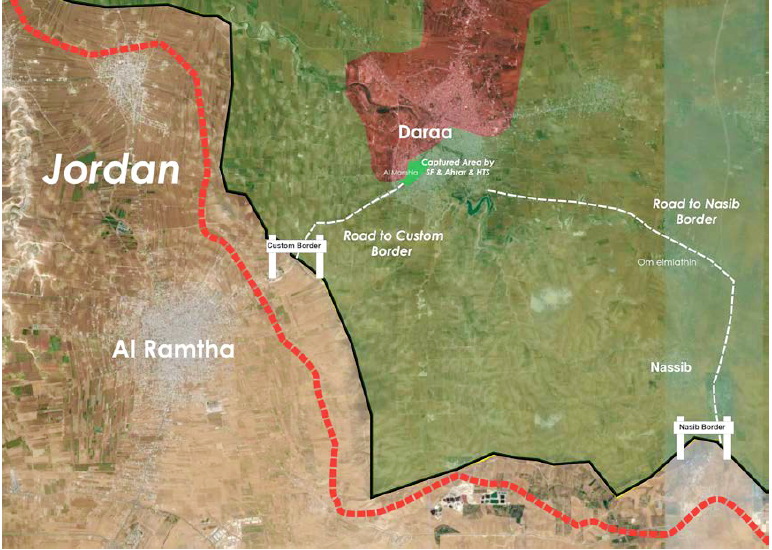
Map showing the location of the February battle between rebels and pro-government forces to capture the border crossing with Jordan. (Nawar Oliver)
The partial truce came only after “repeated” failed attempts to seize the city, Major Issam al Rayes, spokesman for the Southern Front coalition of the Free Syrian Army (FSA), told Reuters. “The regime’s forces have stopped their military operations after big losses in equipment and men since the start of their campaign over a month ago,” he added.
According to a statement from the rebel military operations room known as al-Bunyan al-Marsous, at least 40 members of pro-regime forces were killed in recent clashes in Daraa, including high-ranking officers, such as Ahmad Fayez Tajo, who directed fighting in Zabadani city and Darayya district. Senior Iranian military adviser Haydar Jalilond was also killed in fighting in Daraa, according to the Iranian Nasim news agency.
Foreign Interests in Daraa
The Syrian government is not the only side fighting in Daraa with foreign allies. Jordan, which shares a 235-mile (375km) border with Syria, and its allies have maintained relations with rebels to deter fighting and keep the border region relatively free of hostilities. As a result, until February, Daraa had largely been considered a de facto safe zone – despite intermittent Syrian airstrikes.
The southern provinces are largely under the control of Syria’s armed opposition, comprising roughly 40 Free Syrian Army-linked factions operating under the Southern Front umbrella. The Southern Front has received varying degrees of training and funding from countries in the joint Military Operations Center (MOC) between Western and Gulf states based in Amman. This has enabled Jordan to exert control, with tacit consent from the U.S., Israel and Saudi Arabia, over rebel factions near the Israeli-controlled Golan Heights, southern Daraa province and the Yarmouk Valley.
Until February, the MOC had also been able to regulate the majority of activities between Southern Front factions and the Syrian regime. For example, in August 2016, the MOC reportedly offered Southern Front rebels monthly salaries if they refrained from an offensive against the government-controlled town of Sheikh Miskeen. This is just one instance of how Jordan had managed to keep a relative level of calm in the south before February.
Table showing the change in percentage of control of the different groups in southern Syria before and after the recent offensives. (Nawar Oliver)
When fighting broke out in February, the Jordanian government’s initial reaction was to close 55 miles (90km) of its border with Daraa and Quneitra, denying entry to everyone, including injured civilians. The MOC responded by attempting to persuade the Southern Front factions to stop the battle or halt their participation – signaling that Jordan did not consent to the fighting.
One source close to the situation, who requested anonymity for security reasons, suggested the battle was not a rogue move by the rebel groups, but rather an American plan to deter Syrian government- and Iran-backed pro-government forces from taking control of the border crossing with Jordan so close to its ally Israel. The U.S., Jordan, the Gulf States and Israel, on varying levels, oppose a strong Iranian presence on the southern borders – one of the main obstacles for foreign cooperation in a southern safe area.
‘Act for Daraa’
Daraa was not always a hub for foreign interests. The city, the homeland’s shield, was considered the spark that ignited the uprising against President Bashar al-Assad’s government in 2011.
The relative calm in Syria’s south in recent years has largely kept Daraa out of international headlines, but six years on residents and activists in the city are once again mobilizing to try to put an end to violence against civilians.
They started the “Act for Daraa” social media campaign on June 12 to raise awareness of the situation in the southern city. Using the hashtag #ActForDaraa, activists share photos, videos and reports of attacks in Daraa on various social media platforms. Some have also organized various sit-ins and demonstrations, and social media users around the world have posted pictures of themselves holding signs in support of the campaign.
Written by Housen Akoush, Nawar Oliver
Published In The syria deeply, 23 june 2017,

